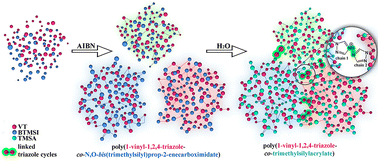Synthesis and characterization of hydrophilic functionalized organosilicon copolymers containing triazole and silylimidate/silylacrylate groups†
Abstract
New heat-resistant functional copolymers of poly(1-vinyl-1,2,4-triazole-co-N,O-bis(trimethylsilyl)prop-2-enecarboximidate) (poly(VT-co-BTMSI)) of various compositions have been synthesized by radical polymerization using AIBN as an initiator. The poly(VT-co-BTMSI) copolymers have been characterized by elemental analysis, Fourier transform infrared spectroscopy, NMR spectroscopy, gel permeation chromatography, dynamic light scattering, thermogravimetric analysis and differential scanning calorimetry. The copolymerization constants (rVT = 1.361 ± 0.078 and rBTMSI = 0.273 ± 0.029) indicate the high reactivity of VT. The copolymers showed a unimodal molecular weight distribution. The weight average molecular weight varies from 79 kDa to 158 kDa, with the polydispersity index ranging from 1.87 to 2.06. According to scanning electron microscopy, the poly(VT-co-BTMSI) copolymers have a highly spongy surface. It has been shown that with an increase in the amount of VT in poly(VT-co-BTMSI), the effective dynamic diameter of the macromolecular coils increases from 8.3 to 11.2 nm. The synthesized poly(VT-co-BTMSI) undergoes hydrolysis to form a new functional copolymer poly(1-vinyl-1,2,4-triazole-co-trimethylsilylacrylate), which forms supramolecular structures in an aqueous medium due to the intermolecular interaction of triazole groups belonging to different macromolecular chains of the copolymers.



 Please wait while we load your content...
Please wait while we load your content...